
Treating Burns Page Selection Menu: 1 2 3 4 5 6 7 8 9 10 <<First
Treating Burns During the Golden Age of Piracy, Page 10
Burn Treatment - Scar Treatment
There is some attention given to the scars resulting from burns, which may seem surprising to those who believe
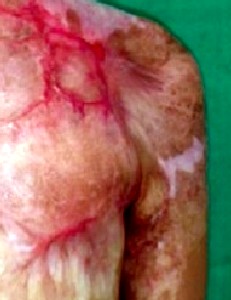
Image:Goel A, Shrivastava:
Immature Burn Scarring of Shoulder
that normal people during this time would have readily accepted disfiguring marks as a part of their existence. William Fabry begs to differ.
A Light Combustion, where the skin is only hurt, although it be something painfull, yet it may easily, and in a short time be cured, and there will scarce any scarre be perceived, if the cure be rightly instituted, and according to Art: But contrary, a great Combustion is hard to be healed, which also leaveth behinde it a filthy and withered scarre, by reason of the perdition and contraction of the skin, if pustils [blisters] do not appeare in the beginning.1
Fabry then goes on to explain how the surgeon can go about encouraging blistering, which was covered in the previous section.
Surely, you may think to yourself, the rough-and-tumble sailors of this time period would give no thought to scarring. They might even view such things as a sort of badge of honor. However, sea-surgeon John Atkins gives advice on scarring to his fellow sea surgeons, explaining that for gunpowder burns, "such Grains as superficially stick [in the skin], may from time to time be picked out with a Needle, as the Digestive [medicine] loosens [them], or if not, they have a less dishonourable Mark then a Scald with Porridge." (OK, so Atkins does suggest there is a certain amount of glory in receiving a scar as the result of a gunpowder burn as opposed to a kitchen burn.)
1 Guliielm. Fabritius Hildanus aka William Fabry, His Experiments in Chyrurgerie, p. 9; 2 John Atkins, The Navy Surgeon, p. 177
Burn Treatment - Facial Burns
"[1704] We had by good Providence none of our Men either kill’d or wounded by the Enemy [a Spanish Man of War]; only two thro’ carelessness had their Hands and Faces blasted; but in a small time they both recovered." (William Funnell, A Voyage Round the World, p. 56)
Facial

Image:US Nat'l Library of Med.
Facial Burn Scars
burns were of particular concern because the surgeon wanted to prevent as much of the scarring that would result as he could. When discussing burns, naval surgeon John Atkins explains that "The Face as being most exposed, and most the Pride of Man, cannot be too carefully watched."1 William Fabry focuses upon another aspect, noting that burns "of the head and face do leave behind them smooth scarres, for the skin is so dryed and contracted with the fire, and the pores so shut, that the haire will never after come forth, nor grow."2
Fabry suggests that the first order of business when treating gunshot burns to the face is to remove "any of the graines or corns of the powder [that] doe sticke in the skin, [and] face"3. He goes on, noting that " presently [gunpowder left behind] must be gotten forth with a Needle or some other sharpe Instrument, afterwards heed is to be taken that pustels [blisters] do not rise; by this means the 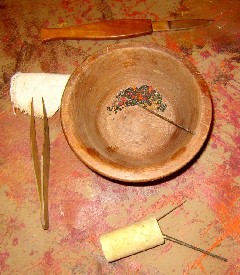
Tools for Removing 'corns of powder'
powder which is in the skin may easily be drawne forth, and the skin mundified [cleansed]."4
Sea surgeon John Moyle concurs, suggesting "If the face be burn'd, pick out the Corns of powder with your Needles, some [of them at] each dressing."5
If the surgeon misses the opportunity to remove the powder before blistering occurs in the face, Fabry suggests the following:
Rx. Cantharidum [Spanish flies] {6 each}. Fermenti {half-ounce}
Mix them in a Morter with a drop or two of Vinegar, of the which make a little plaister and apply upon the spots, but you ought to take great heed that this Ointment come not unto the eyes, when the pustels [blisters] doe first arise, let them be cut with cizors, then let the powder be taken away either with a Needle or some other sharpe instrument6.
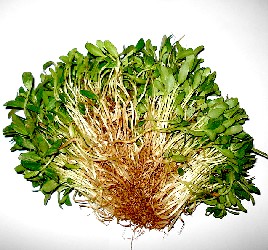
Image:Wiki User Miansari66
Fenugreek
After this, repeated application of an unguent and a wash of fenugreek or melilot [sweet-clover] water are used until the wound is 'sufficiently' cleansed.
For burns of the face where powder removal is not an issue, Fabry suggests another ointment:
Rx. Gum. Elemni [gum resin] {1 dram}, Oleum de vit. Ovor, Rosar. [oil of roses and egg yolk] Ana. {mix 3 drams}. Saponis Albi & veneti [white and venetian soaps] {2 ounces} Let the gums be dissolved with the Oyle, and all diligently mixed in a Morter, & make an Ointment, which being spread upon a linen cloath, apply it all over the Face, and every foure hours renew the emplaister6
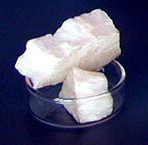
Photo: Genevieve Anderson
Spermaceti Wax
Atkins advises a much simpler concoction, claiming that "the common Cosmetick is Ol. Amygd. [oil of almonds] & Sperma Ceti [spermaceti - a wax found in the head cavities of the sperm whale]."7
For
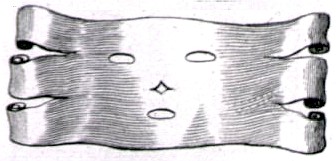
Artist: Antonio Baratti (1772)
Linen Face Bandage From L'mpreimerie de Editeurs, p. 90
dressing burns of the face, Atkins suggests using "a Mask of Linnen, guarding the Eyes against the Digestive [medicine to build tissue] its armed with... moistening this Mask two or three times a Day with thin Digestive, such as may continually malax and soften without exposing directly to Cold and Medicine, but then this can be only the first Day or two, for with Maturation it becomes necessary to remove"8.
In his memoirs, while explaining the treatment for a face an neck burn John Moyle applied "Linteolas [small pieces of soft lint] and pinned [them] lightly on, for these sores must not be bound with Rowlers"9.
1 John Atkins, The Navy Surgeon, p. 177; 2 Guliielm. Fabritius Hildanus aka William Fabry, His Experiments in Chyrurgerie, p. 10; 3 Hildanus, p. 25; 4 Hildanus, ibid; 5 John Moyle, Abstractum Chirurgæ Marinæ, p. 67; 6 Hildanus, p. 25-6; 7 Hildanus, p. 23; 8 Atkins, ibid.; 9 Atkins, ibid.; 10 John Moyle, Memoirs: Of many Extraordinary Cures, p. 116
Burn Treatment - Guarding the Eyes
Of particular concern with relation to burns of the face were the eyes as you will have noticed in the previous section on burns of the face. Several period surgeons advise against
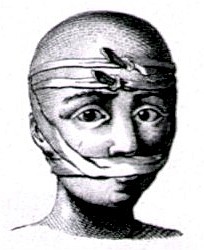
Artist: Antonio Baratti (1772)
Bandaging Around the Eyes
From
L'mpreimerie de Editeurs, p. 90
using certain medicines on the face because of their effect on the eyes. When extolling the virtues of vinegar-soaked bandages, John Atkins notes that when placing a face mask bandage on a patient with facial burns, the surgeon must take care, "guarding the Eyes against the Digestive its armed with"1.
William Fabry warns that some kinds "of Medicine are not to be applied [to the face] by reason of the eyes"1. He specifically mentions several particular medicines: "Ointment of new Wine boyled to the third part, which was solid and thick, [should not be used] lest it should flow unto the eyes and hurt them"2; "Ointment of Onions doth little or nothing profit to Combustions of the face, for by it the eyes may suffer much hurt and damage"3 and finally "Sope is not to be used by reason of the eyes"4. In the last recommendation, Fabry suggests the surgeon use Rose or
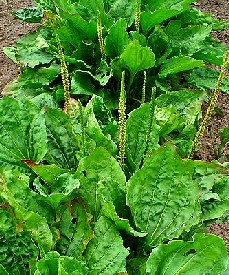
Photographer: H. Zell
Plantago Major
Plantain (Plantago) Water in place of soap.5
He also gives a detailed concoction to be used for second degree burns in place of onions, although it rather curiously contains the soap he warned the surgeon not to use elsewhere:
...therefore [use] this following Ointment is used in place of the other.
Rx. Saponis Veneti [Venetian soap] {1 ounce), olei Roser [rose oil] & Amigdalar dulcium. [oil of sweet and bitter almonds] ana. {half ounce) misce [mixed]
Make an Ointment in a Morter, adding a little quantitie of the Musilage of Cydon seeds [quince seeds] extracted with Rose-water; It is to be noted, that although the wine thin[ned] is not to be rejected in Combusions [burns], yet to the face we ought by no meanes to apply it so, for it moistneth, and penitrateth, and offendeth the eyes; wherefore wee ought to take great heed that this foresaid Ointment be not too liquid6
It may be that in making this ointment thicker and less fluid, he felt the concoction could be kept away from the eyes during application.
1 John Atkins, The Navy Surgeon, p. 177; 2 Guliielm. Fabritius Hildanus aka William Fabry, His Experiments in Chyrurgerie, p. 29; 3 Hildanus, p. 22; 4 Hildanus, p. 24; 5 Hildanus, p. 33; 6 Hildanus, p. 24
Burn Treatment - Burns of the Eyes
It doesn't take much to imagine people firing weapons to receive hot sparks in their eyes. While no period accounts of this happening at sea were found in the review for this article, Stephen Bradwell relates an interesting story of injury
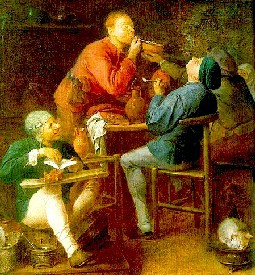
Artist: Adriaen Brouwer
The Smokers (mid 17th century)
to a young girl's eye on land which burned here eye, giving details of how he treated the wound.
[S]ome Gentlemen were taking Tobacco; and as one had knocked out the snuffe or coale of it on the Table; another in jest blew it toward him, he also blew it at him againe. This began to be pursued from one to the other, till a little Girle looking on (whose height was little above the Table) received the evill of their jesting; for some of the burning coale of Tobacco was blown into her eye. It tormented her extreamely (as nothing burneth more terribly)
I ran into the garden, where I found some ground Ivie, whereof I gathered some, which I stamped, and strayned, and putting a little fine powdred Sugar to the Juice, I dropped some of it into her eye; upon which she received sudden ease, and had it not applyed above twice more, before she was perfectly well: But in the meane time, her eye was muffled up from the outward ayre.1
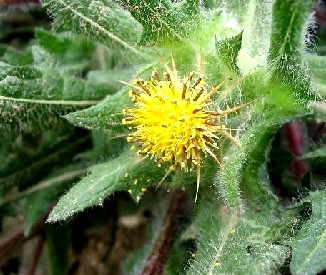
Photographer: Alberto Salguero Quiles -
Blessed Thistle
Bradwell gives another recipe for curing burns of the eye when "a sparke of Fire may leap into it. For this, the white of an Egge beaten with Eye-bright water, or Carduus water [made with blessed thistle or Cnicus], is very good; if you drop now and
then a drop of it into the eye. But the Plaster of Carduus described in the 8. Chapter is most soveraigne."2
The description of the plaster (used in this particular case on "a young man stung in the eye-ball with a Bee") reads, "Upon the place, I applyed this Plaster, I tooke a handfull of Carduus benedictus newly gathered, pounded it in a morter very fine, and mixed it with the white of an egge, so spreading it upon a pledget of flaxe, I laid it to the eye, and as it waxed dry, renued it twice."3 He goes on to note that this medicine "is good for all burnings in, or about the eyes."4
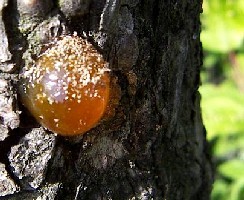
Photo: Rencas - PlumTree Gum Resin
Military surgeon Richard Wiseman has several suggestions for such burns. "In burns of the Eyes you may use Pigeons blood, Breast-milk, aq. solani [bittersweet water - made from Solanum dulcamara], plantag. [plantago water] ros. [rose water] poma. [pomatum - made from lard and water] sem. cydon. [quince seed water], fœnugr. [fenugreek water], troch. abl. Rhas. tutia [a concoction of lead oxide, Sarcocolla or gum resin & egg white], lap. calm. [Lapis calaminaris - calamine] thus., sarcoll. [gum resin] washt or not washt."5
For more on treatment of the eyes, particularly focusing on herbs period surgeons felt were friendly to them, read the article Eye Wounds and Surgery During the Golden Age of Piracy.
1 Stephen Bradwell, Helps For Suddain Accidents Endangering Life, p.122-3; 2 Bradwell, p.121-2; 3 Bradwell, p.49; 4 Bradwell, ibid.; 5 Richard Wiseman, Eight Chirurgicall Treatises, 3rd Edition, p. 432

